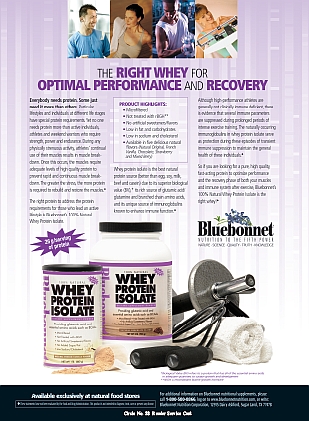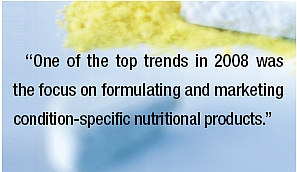Everything is made from something. It all starts from very basic materials. Decades of human ingenuity and fortitude to continue the quest of constant improvement add to the mix of effective and valuable finished goods. The dietary supplement and related functional foods industry is a shining example.
Curious customers often ask natural product retailers, "Just what exactly is in this product and how do I know these ingredients will work?"
In essence, it's all driven by institutional research in tandem with raw material manufacturers that provide consistent qualitative starting ingredients based on compelling research results. These suppliers work closely with finished-product manufacturers and marketers to fill shelves with novel supplements and functional foods that convey specific, targeted health benefits.
Increasingly during the past decade, logos and exotic brand names are showing up on bottles, packages and literature—these are the proprietary raw materials that are intended to convey quality and a bit of cache to consumers. Trademarked proprietary ingredients have taken center stage in raw material supply and have altered the supplier–manufacturer relationship as well as affected the retail environment, turning a once generic inventory into a surging sea of "designer" ingredients and products aimed at attracting loyal consumers.
Adding to the surge—and sustaining excitement—many raw materials suppliers are opting for their own specialty niches, creating in-depth brand portfolios to support an ingredient or family of ingredients. Many of these companies have slowed product launches, opting to invest time and money into proper sourcing, research and development, and extensive marketing platforms to ensure launch success.
 2008 Activity Overview
2008 Activity Overview
"In 2008, we saw an increase in manufacturers and marketers seeking new raw materials and products," observes Hartley Pond, vice president of sales for Van Drunen Farms/FutureCeuticals, Momence, IL. Areas that have been strong for FutureCeuticals are traditional superfruits such as blueberry, cranberry and berry blends, plus the "newer superfruits" such as mangosteen, goji, acerola cherry, açai and the company's patented CoffeeBerry. FutureCeuticals has also continued to participate in rapid new product development with its patented functional soluble fibers from oat and barley (Nutrim, BarleyTrim, Calorie Control Trim) for a variety of health conditions including the modulation of lipids and glucose and insulin.
Consumers shop the supplement aisles by needs and desires to address specific conditions, notably weight management, energy sustenance, stress/anxiety/mood, blood sugar/diabetes control, joint health, heart health, immune-boosting and overall fortification (multivitamins). The top health concerns remain rather static, yet, as retailers can indeed attest, there is a gathering momentum of new supplements vying for shelf space. This is good news, as it demonstrates an industry of consistent product innovation.
In a news article on NutraingredientsUSA.com, November 20, 2008, Fortitech, Inc., Schenectady, NY, asserted that the three areas of health for which it received the highest number of customer inquiries in 2008 were digestive health, sleep and mood, which were emerging areas. Interest also included the top areas of obesity, cosmeceuticals and cardiovascular health. In addition, the same article referenced 2008 Mintel research showing that 159 new food and beverage products targeting digestive health were introduced last year. Compare this amount with 81 such products in 2007 (YTD, 11-20), 39 in 2006 and 17 in 2005.
Nutratech's product portfolio is centered on weight management and velocity in that category is brisk, says Bob Green, President of Nutratech, West Caldwell, NJ, maker of Advantra Z, its proprietary bitter orange extract. "We are experiencing double-digit growth. This is because people are getting fatter by the day. With obesity such an issue for millions of consumers—and a primary cause of so many health concerns such as high blood pressure, high cholesterol, heart disease and diabetes—we don't see an end to the need for natural thermogenic weight management solutions," says Green.
It seems the activity of brand marketers using raw materials has been driven by trends originating in two key areas: condition-specific efficacy and sourcing-specific safety profiles, observes Paul Dijkstra, CEO of InterHealth Nutraceuticals, Benicia, CA, which recently received ISO 9001:2000 certification. He asserts that one of the top trends in 2008 was the focus on formulating and marketing condition-specific nutritional products as opposed to products marketed for overall long-term good health; this is spurred by an aging consumer base seeking these products in an effort to avoid or control degenerative diseases. This concept is particularly strong in the dietary supplement category, but has spilled over into food and beverages as well.
Safety, Dijkstra comments, remains prominent in the dietary supplement and food and beverage industries, and "this has been of particular importance since certain ingredients and products imported from China have been inundated by scandal. This has highlighted the importance of rigorous quality control, testing and traceability. Furthermore, good manufacturing practices (GMP) requirements encourage more supplement companies to source ingredients based on quality instead of just price."
"The increased regulatory activity in the industry has had a definite effect on the rate of innovations in the past year," states Eric Brown, sales director at Bergstrom Nutrition, Vancouver, WA. "With an increasing number of dietary supplement manufacturers having to adopt GMPs and increasing due diligence of science-based ingredients, the rate of innovation has slowed in order to fulfill the increased threshold of accountability," he explains.
In 2008, Allendale, NJ-based Lonza continued to experience another solid year of growth, according to Michael DeGennaro, global head of sales and marketing for human nutrition. "Still, we saw many economy-driven changes this year, as a greater amount of attention is being paid toward quality standards and escalating raw material costs, he says."
When the executive team at Los Angeles-based OptiPure finds products with tremendous market potential, they are evaluated for their potential to be successfully promoted and sold, says Ron Udell, president and CEO. As the market stands now and for the immediate future, "unique products are becoming harder to find, and it is increasingly imperative to have clinical studies and technical data for support of the ingredient. As the market becomes more saturated with effective products, there are also those that push for new, exciting products without first doing their research. The main problem we have is sorting through the high-potential products from the low, and forming a solid trademark around them that no one else has."
"As a multi-faceted manufacturing and marketing company, Pharmachem (Kearny, NJ) noticed interesting trends in processing projects, rote raw ingredients and branded ingredients across the board," observes Mitch Skop, director of new product development. "While there continues to be bread-and-butter sales of ingredients to small and mid-size companies, the emergence of large multi-nationals seeking innovation and modernization has been interesting to us."
Late in 2007, reports Shaheen Majeed, director of marketing at Sabinsa, Piscataway, NJ, Sabinsa had several conversations with contract manufacturers that indicated they are looking to consolidate their ingredient suppliers. In tandem, he notes, the marketplace also is indicating a need for closer relationships with suppliers as more and more regulatory questions are coming into play. "From the new GMP requirements to how some companies want to do business overseas, many suppliers simply can't provide their customers with the right or even adequate paperwork to facilitate their operations," he says. "Additionally, contract manufacturers and marketing companies are asking for ingredients that are extracted in a certain manner, or with a particular solvent—specifically for passing regulatory tests or sometimes even satisfying a specific consumer demand."
 Weathering the Recession
Weathering the Recession
Unfortunately, 2008 will be remembered as a bleak year with a snaggle-toothed recession sure to leave a bite mark on many Americans and their families.
However, the dietary supplement industry is flexible—as well as hale and hearty, despite increasing economy-driven challenges.
"Difficult economic times have made finding growth opportunities in today's marketplace challenging," concedes Dijkstra. "But even in a difficult market, there are consumer needs to be met and opportunities to pursue. Consumers are becoming more aware of the benefits of a healthy lifestyle and will continue to seek support from functional food and beverages and dietary supplements for their health concerns. High-quality, effective and safe ingredients that provide substantial health benefits increase consumer value, differentiate products and secure competitive advantage in today's troubled market."
Brown believes that there are multitudes of trade-offs in every economic situation. "When the economy was overheated, the dollar was weak and inflationary costs such as fuel, plastics and cardboard were increasing," he relates. "Meanwhile, import products were increasing in cost at an alarming rate. Enter the recession—stronger dollar, lower fuel costs, lower import costs, etc. What does that mean with consumer behavior is quite simple—why purchase today what will be less expensive six months from now?"
Although this is true for many products such as electronics, clothing, household appliances and others, dietary supplements are viewed as needed NOW. However, despite the sense of immediacy with supplement product purchases, Brown states that disposable consumer spending will be down in this economy. Consumers will be wary and sensitive to costs as well as the benefits they receive from the supplements they take. "Therefore," he declares, "innovation needs to accelerate. Marketers need to provide customers with a properly researched ingredient, or combination of ingredients, at a competitive price point and deliver on what they propose."
Historically during economic downturns, says Green, Nutratech has seen sales of weight management products increase. "This could be because people often find solace in food and drink when they're worried or depressed. But I think it's also because people start taking responsibility for their own healthcare as healthcare is a huge and challenging expense for Americans. During recessionary times, consumers minimize trips to doctor and the need for medications. Individuals with diabetes, high cholesterol or heart disease know full well that weight loss will not only benefit their health, but also their pocketbook by saving on medical bills, and often sales of these supplements increase."
 Scott Daniel, marketing manager of National Enzyme Company (NEC), Forsyth, MO, asserts that she believes it is important for retailers to continue to add new products to the shelves because "their shoppers are going to continue to shop."
Scott Daniel, marketing manager of National Enzyme Company (NEC), Forsyth, MO, asserts that she believes it is important for retailers to continue to add new products to the shelves because "their shoppers are going to continue to shop."
"First thing to realize, we're consumers as well," emphasizes Majeed, who points to how the recent astronomical gas prices changed consumer behavior. "We should consider our customers are also going through necessary frugality and more self education about products. Maintaining a strong sense of unwavering confidence in what we provide to the ultimate end user is imperative. At Sabinsa, research is the priority, affording us confidence in ingredient efficacy and safety, and our marketing partners also buy into this confidence, which is then conferred to their retailer accounts," he explains. But, Majeed cautions the supply industry not to cut back on research: "A product that is well researched now will flower to great success in the future. Yet often, research is one component that many companies cut out."
Similarly, Dijsktra asserts, financial woes frequently lead to constrained resources that may also impact the overall research pipeline of suppliers with postponed development of new technologies and delayed clinical, application and feasibility studies. There is concern that quality assurance and control may suffer in light of reduced resources available.
However, several suppliers remain steadfastly optimistic. Skop says, "While we see some budgetary restraints on their part, we also see a lot of hope and faith that wellness products will continue to be supported by loyal customers, even through tough financial times."
 2009 will be challenging to navigate, agrees DeGennaro. "Companies may stay cautious, control spending and manage business very closely. We will continue to focus on what we do best: provide security of supply, business support and science-backed ingredients that the marketplace can trust," he says.
2009 will be challenging to navigate, agrees DeGennaro. "Companies may stay cautious, control spending and manage business very closely. We will continue to focus on what we do best: provide security of supply, business support and science-backed ingredients that the marketplace can trust," he says.
As of yet, states Daniel, NEC has not yet seen a big slow down. "We are prepared for that to happen, but we are not cutting back on any of our 2009 plans for growth. We will continue to launch new products and support them as usual," she says.
In agreement is Dijkstra, who says as a supplier of branded raw materials, it is important for InterHealth to continue its marketing campaigns to sustain product brands in difficult economic times. "We will continue to talk about the power of our strong brands in the face of declining customer spending. And because research is the backbone of our brands, we will continue to build our product substantiation by conducting well-designed studies."
This benefits everyone from marketer partners to distributors/brokers, retailers and of course, consumers. It is a known fact that companies that maintain marketing and public relations (PR) efforts in a down economy retain—and gain—business, notably from those who buy into the hysteria and cut out ad spending, leading their customers to believe they are casualties of recession. Sources for this article emphasize the importance of retailers being visible: network, engage in PR and ensure community advertising and media remain prominent. If you don't, your competitors will.
Mass Media Impact
Undeniably, mass media reports are supportive of dietary supplements one day and the next, disdaining. This "every which way the wind blows" matter of mass media stories about university level research of dietary supplements seems rather schizophrenic, especially for the increasing number of Americans who are willing to incorporate dietary supplements into their lifestyles. Through the years, there is a noticeably growing population of people who try dietary supplements and stick with the regimen and concept of self-healthcare with supplementation.
Still, conflicting messages from mass media are an ever-increasing problem for raw material suppliers, brand marketers and retailers alike who are routinely besieged with consumer questions centered on efficacy and safety. And, unfortunately with such search engines as Google, the specters of bad ink haunt with every search, keeping it all alive to confound and befuddle.
And because we now exist in a mass media "Google Age" where video, articles and blogs are evergreen, they live on and on for consumers to skim through with every search, points out Majeed. He encourages brand marketers and retailers to keep aware of this fact, and take the time to take the temperature of attitudes and what facts may be out there about any given supplement and their effect on health conditions. "The mass media certainly can drive consumer attitudes, and sometimes to extreme ends. Then of course, the middle is what I consider where the consumer is just left confused. Honestly, if it's at that point for a long period of time, no brand marketing or efforts in re-building a product can help re-establish it in their minds," says Majeed.
"Our sense is that issues of health, disease, prevention and wellness remain core topics of interest to the consumer and thus have been prominently discussed and analyzed in the mass media," relates Pond. "Certainly the attention of mass media always grows categories. Currently, this is seen in categories such as probiotics, glucose control, superfruits and a significant focus on the plethora of good news on vitamin D have led to discussions and the initiation of projects with our partners and customers."
Daniel says she has seen the mass media continue to impart a huge impact on the consumer; it has caused massive drops in sales for numerous ingredients and products, such as vitamin E, when research is reported of a particular non-effect in specific cases. At the same time, she adds, simply one mention on "Oprah" and the product or ingredient sales spike through the roof. "Over the past few years I have seen that supplements have become more and more a part of the mainstream. More conventional physicians are starting to recommend supplements on a regular basis; pharmaceutical companies are buying supplement companies or launching their own line (Bayer). In the case of NEC's core focus," she says, "fortunately, enzymes have been positively affected by the mass media attention to probiotics and digestion. Dannon has done an amazing job of promoting not only probiotics but digestion as a whole."
But often, purposeful spin to massage sensationalism can mislead the public. Skop says, "We and our marketers-manufacturers focus on re-instilling consumer confidence which is often rattled both by errant reports of misinterpreted studies and by cowboy marketers making claims and promises that their products can't live up to."
 Indeed, agrees Dijkstra, mass media has a far-reaching effect on consumers' perceptions not only on health, but also in every product and service sector. No doubt, the majority of consumers look to mass media as a guide in their decision process. "We have seen that brands such as Ester C highlighted in mass media articles receive consumer attention and shape their attitude towards them as superior and drive their purchasing behavior."
Indeed, agrees Dijkstra, mass media has a far-reaching effect on consumers' perceptions not only on health, but also in every product and service sector. No doubt, the majority of consumers look to mass media as a guide in their decision process. "We have seen that brands such as Ester C highlighted in mass media articles receive consumer attention and shape their attitude towards them as superior and drive their purchasing behavior."
Further, major advertising campaigns influence perception and spur sales, and Dijkstra notes that InterHealth's partner companies have shown that their sales revenues are directly linked to their advertising as long as the messages are clear to the consumer. This is good news for industry overall, he says, as other non-branded ingredients have also directly benefited from exposure of the brand in mass media communications. "Positive mass media coverage of generic ingredients such as fish oil or glucosamine/chondroitin can tie back to increased consumer familiarity with those ingredients that ultimately drives their purchasing behavior. Manufacturers as well as ingredient suppliers must proactively use the media to convey the efficacy and safety behind nutraceuticals and the regulatory environment that is involved in manufacturing nutraceutical products."
Further muddying the waters is the plethora of ingredients that seem to be brands, but really are not, points out Eric Anderson, brand manager at P.L. Thomas, Morristown, NJ, who states that a brand is designed to convey the unique properties of a product. A branded ingredient differentiates and distinguishes itself clearly from the competition and delivers to the consumer a consistent experience. "Fifteen years ago, when industry started to brand a handful of products, such as CitriMax, Ester C and Tonalin, for example, these were going out to educate the retailers and the consumers about what made them so unique and proprietary. Today, there are thousands of brands, but they are not truly brands. They are commodities that are not unique and don't have differentiating features and are not being marketed to retailers and consumers to educate them about the proprietary nature of the particular product. You have thousands of commodities with funny names and logos that are not creating any value in the distribution chain. These ingredients are making more noise, more confusion and increasing demands on companies that are marketing finished products to incorporate logos and license agreements."
Retailers can certainly take the time to assess a new ingredient: what makes it unique? Does it have a unique source of supply, a proprietary manufacturing process, method or use patents, clinical research substantiating its efficacy? Anderson stresses that these are the qualities that make an ingredient a brand that creates value in the marketplace.
Challenges to Remain Competitive
When you read about the launch of a new ingredient in the WholeFoods "Supplier News" department, think about it as part of an ever-increasingly complex journey.
Brown notes that the key to new supplement ingredients making their way to the consumer is a meticulous matrix of due diligence, commencing with the most basic (NDI or ODI). Other elements include price, regulations, science, patents, quality assurance, certificates of analysis, uniform specifications, analytical standards, consistency of manufacturing, storage, shelf-life, manufacturing capabilities, formulation considerations, possible combinations and possible side effects (alone or in combination).
"The most significant challenge," he emphasizes, "is to assess the science on any ingredient—animal or human, epidemiological, blind or double blind, statistical sample size, results, and repeatability of the results," he explains.
However, Green states he doesn't necessarily see new product trends as the result of research, sourcing or international regulations. "Trends emerge when products address consumer needs and wants," he says.
New product development can be spurred in a variety of different ways, says Dijkstra. First, it is important to do a thorough examination of market drivers and marketing trends, including health, wellness and dietary patterns and interest in nutraceutical food and beverages. Development in ingredient technology is certainly a driver of new product development. Taste, texture and solubility issues have often limited the types of ingredients that can be added to foods and beverage. Developments in ingredient technology have allowed food and beverages companies to incorporate an ever-expanding range of nutraceuticals into their products without compromising taste, texture or nutritional needs.
 He adds that ingredient sourcing problems or international regulations may limit a product's distribution and thus sales. A supplier may have an ingredient that is clinically proven safe and efficacious, but if it encounters sourcing or regulatory issues, they will impede the sale of a product and ultimately, the product may not be worth developing. "Ingredients that have a guaranteed supply chain, a sustainable ingredient source and have gained international regulatory acceptance could peak the interest of many companies and increase the inclusion of these ingredients in new products," he explains.
He adds that ingredient sourcing problems or international regulations may limit a product's distribution and thus sales. A supplier may have an ingredient that is clinically proven safe and efficacious, but if it encounters sourcing or regulatory issues, they will impede the sale of a product and ultimately, the product may not be worth developing. "Ingredients that have a guaranteed supply chain, a sustainable ingredient source and have gained international regulatory acceptance could peak the interest of many companies and increase the inclusion of these ingredients in new products," he explains.
For an ingredient to become trendy (e.g., chia seed, tropical superfruits), Daniel says all of the dynamics from research to marketing must fall into place, and it can happen on its own or through an orchestrated effort. "To spur a new product trend, I think first there has to be something new or novel about an ingredient—hopefully in the form of clinical research. A good clinical trial and an excellent PR agent can go a long way in causing a major media stir for an ingredient."
As a vertical supplier with a variety of dehydration and extraction technologies, Van Drunen Farms/FutureCeuticals is able to offer new fruit and vegetable products quickly after it has established a reliable raw material source and has vetted the existing science and the safety of a product. "We certainly react to market trends," remarks Pond, "however, most of current product development is focused on discovery of new compounds that have specific activity and available intellectual property potential."
Increasingly, suppliers now invest in research on their specific compounds to get away from the "borrowed science" trend of the recent past. OptiPure, Pharmachem and its subsidiary PNI, Nutratech, NEC, Lonza, PL Thomas and others have found successful means and methods to engage in scientific research for their signature compounds. These companies likewise ensure that full study results and analyses are easily obtainable through their Web sites. These suppliers enjoy working with retailers who sell the products featuring their ingredients, and most will be happy to give any tech assistance to retailers and their staff members.
Retailers take note: "We expect to see a return to basics; home life is back in fashion," states DeGennaro of Lonza. "We remain positive that spending on good nutrition as part of a person's overall control of general wellness will remain a key priority." WF
Lisa Schofield is a freelance writer based in Freehold, NJ.
Published in WholeFoods Magazine, January 2009









